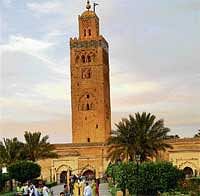In search of Marrakesh

Someone was playing ‘Marrakesh Express’ by Crosby, Stills and Nash. Lennon and McCartney were lounging on some rooftop close by. Jimi Hendrix was spotted with a guitar slung over his shoulder while Jagger and Richards had just rocked into town. A heady whiff of anticipation hung in the air – or was it hashish? Probably both. It was the 1960s. And it was Marrakesh.
Back then, this city in Morocco played host to famous visitors and hippies alike. Along with Delhi, Istanbul, Kathmandu and Kabul, Marrakesh was one of those legendary destinations that formed part of the overland hippy trail from Europe to India. For that reason alone, it has held a special place in my imagination, and after many years of yearning for Marrakesh, I recently had the opportunity to visit the place.
My view of Marrakesh, still being stuck in a kind of hippified 60s time warp was shattered within minutes of arriving, as I spotted one of the plushest McDonalds I've ever seen in the clean and modern new town, which was built by the French. With its modern buildings, pavement cafes and uniformed waiters serving croissant at ‘Cafe Noir’, for a moment, I almost thought I was back in southern Europe.
I came for the raw, the unadulterated and the 1960s. But the 60s are long gone, along with the hippies. I guess today’s tourists require something different. They still want to experience ‘the other’, the exotic, but on their terms. While some hippies and new-age travellers, both young and old, are still kicking around India, the days of the free and easy ‘hippy trail’ seem well and truly over in Marrakesh. Although strong smells of cannabis and patchouli may no longer permeate the enticing hot North African nights, at least not to the extent they used to, the 2009 version of Marrakesh still has much to offer.
Marrakesh has always seduced visitors with its sunshine, palm groves and lovely riads (villas), all set against the backdrop of the Atlas mountains in the distance. But, these days, while it still attracts independent travellers, it is filled with well-to-do vacationers from Europe, who certainly feel at ease here and are enticed by the city’s laid back character.
Of course, the main square, the Square of the Dead or Djemma el Fna, is the hub of the city and the guidebooks describe it as being the best place to drink in the real Morocco, with its food stalls, orange juice stands, acrobats, dancers and snake charmers. And yes, all those attractions are there, but some feel (and I include myself here) that the guidebooks oversell this square and one can go away feeling a little disappointed after having seen it. A cynical tourist trap or a slice of authentic Morocco? It all depends on your expectations. Actually, I ‘drank in’ a flavour of France in the square by indulging in my first ever plate of snails from one of the food stalls. Despite my hesitancy, they were quite tasty, if a little rubbery in texture.
The square is a huge, rambling expanse, which becomes more intimate and truly alive as dusk falls. While southern Europe is only an hour or so away by plane and the new town barely a kilometre away, a different world awaits down the back lanes leading from the square and into the medina. This is where African, Islamic and Moorish traditions collide, from cuisine and customs to architecture and a lot more beside. Away from the water sellers and steaming open-air food stalls in the main square, people can lose themselves in the tight labyrinth-like souks, where hundreds of spice shops, shoe and carpet sellers and handicraft vendors huddle together.
Apart from getting lost in the medina, there are various must-see places in the city, including the Saadian Tombs. The Saadians were an Arabian dynasty that ruled much of southern Morocco in the 16th and 17th centuries, and Marrakesh was their capital. The tombs were sealed and only rediscovered in 1917. They are well worth a visit, given the impressive architecture and finely worked detail.
The impressive 221 foot-high square minaret of the Koutoubia Mosque is the tallest in Marrakesh and is an important city landmark. Dating back to the 12th century, each side of the minaret is decorated with different carved stonework panels and carvings. I guarantee that you won't miss it.
Also, worth seeing is 150 room El Bahia (The Brilliant) Palace belonging to the 19th century. Part of it is closed for visitors because the royal family still use it. Although, you can check out the attractive, well preserved, Harem Courtyard. The Bahia Palace took nearly 15 years to complete but was eventually ransacked, and parts of it are still being restored. The palace is typically Islamic in terms of its architecture, with its central courtyards and rooms leading off. There are fountains and gardens, along with stylish stucco panels and tiled floors.
And when sight-seeing fatigue has kicked in, and it will, given the city’s abundance of historical buildings, public gardens and monuments, why not head off into the sprawling medina? After all, that’s where you will be served up not just an authentic lamb tagine, a delicious plate of couscous or a glass of mint tea, but also a true flavour of today’s Marrakesh.
Perhaps, on arrival, I was expecting too much from Marrakesh and hoped to be transported back to some kind of glorified, overland hippy trail destination of the 1960s. Given the city’s lingering reputation in popular culture, it's an easy thing to do. Don't make the same mistake. Just enjoy Marrakesh for what it is right now —ancient and modern with everything to offer, right from coffee to couscous. For most people, that should be more than enough.